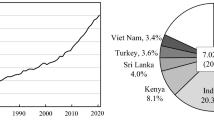Abstract
In this study, 90Sr (540 keVβ −), 129I (150 keVβ −) and the gross beta radioactivity concentrations were determined for the samples of tea as the most leading consumed hot drink in the markets (processed and packaged for sale) in our country. Furthermore, the obtained data were statistically analyzed. For determination of 129I (150 keVβ−), 90Sr (540 keVβ−) and gross radioactivity concentrations in tea samples, a sensor system consisting of scintillation detector with BP4 probe sensitive to beta radiation and a radiation meter (ST7) configurable for windows at desired power was used.






Similar content being viewed by others
References
Pöschl M, Nollet LML (2006) Radionuclide concentrations in food and the environment. Taylor and Francis, Boca Raton, p 113
Bozkurt A, Yorulmaz N, Kam E, Karahan G, Osmanlıoğlu AE (2007) Assessment of environmental radioactivity for Sanliurfa region of southeastern Turkey. Rad Meas 42:1387–1391
UNSCEAR (2000) Sources and effects of ionizing radiation. United Nations Scientific Committee on the Effects of Atomic Radiation, New York, vol 27, p 93
Jabbar A, Arshed W, Bhatti AS, Ahmad SS, Saeed-Ur-Rehman, Dilband M (2010) Measurement of soil radioactivity levels and radiation hazard assessment in mid Rechna interfluvial region, Pakistan. J Radioanal Nucl Chem 283:371–378
Baykara O, Doğru M (2010) Assessment of natural radioactivity and heavy metals in water and soil seismically active area. J Radioanal Nucl Chem 283:547–553
Papp Z, Dezso Z, Daroczy S (1997) Significant radioactive contamination of soil around a coal-fired thermal power plant. J Radioanal Nucl Chem 222:171–176
Gökmen IG, Birgül O, Kence A, Gökmen A (1995) Chernobyl radioactivity in Turkish tea and its possible health consequences. J Radioanal Nucl Chem 198(2):487–497
Canbazoğlu C (1998) Determination of radioactivity level of drinking water use and the region of Elazıg. Frat University Institute of Science, Elazıg
Alkan H (1989) Analysis of drinking water resources in İstanbul pollution, radioactivity and heavy metal pollution. İstanbul University, İstanbul
Karahan G (1997) Determination of natural radioactivity of İstanbul, environmental and natural radyasyonlarnn annual effective dose equivalent. İstanbul Technical University Nuclear Energy Institute, İstanbul
Weast RC (1973) Handbook of chemistry and physics. The Chemical Rubber Co., Cleveland
Külahcı F, Doğru M (2005) Physical and chemical investigation of water and sediment of the Keban Dam lake, Turkey: part 1: iso-curves of radioactivity. J Radioanal Nucl Chem 268:517–528
http://www.riskcenter.doe.gov/docs/cre/factsheets/Iodine. Accessed 22 Feb 2006 (2006)
Author information
Authors and Affiliations
Corresponding author
Rights and permissions
About this article
Cite this article
Şahin, S., Külahcı, F. & Doğru, M. Determination of 90Sr, 129I and gross beta radioactivity concentration in some teas. J Radioanal Nucl Chem 290, 313–318 (2011). https://doi.org/10.1007/s10967-011-1248-y
Received:
Published:
Issue Date:
DOI: https://doi.org/10.1007/s10967-011-1248-y




